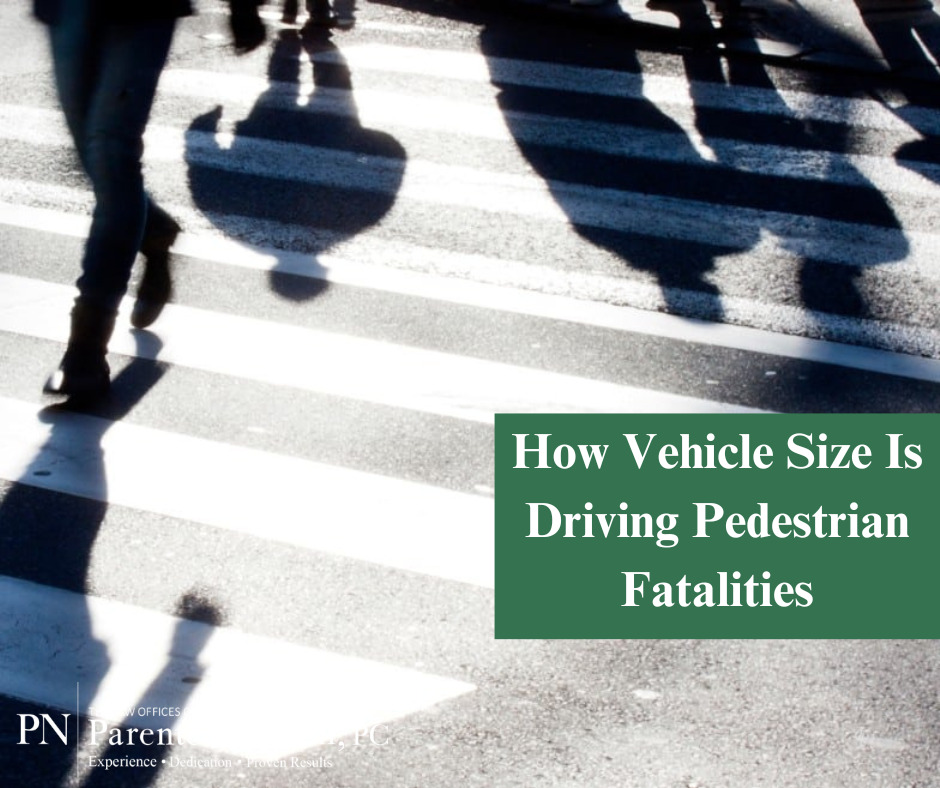
P&N BLOG | How Vehicle Size Is Driving Pedestrian Fatalities
In recent years, there has been a sharp increase in pedestrian fatalities resulting from vehicle crashes in the United States. From 2010 to 2021, the annual number of pedestrian deaths jumped by a staggering 72%, reaching 7,400 fatalities per year. This surge in pedestrian deaths contrasts sharply with the declining trend in motorist fatalities during the same period.
One significant factor contributing to this alarming rise in pedestrian deaths is the growing popularity of larger vehicles, particularly light trucks such as SUVs, pickups, and vans. These vehicles, accounting for 78% of new passenger vehicles sold or leased in 2021, pose a heightened risk to pedestrians due to their larger size, higher front-end designs, greater crash impact force, and larger blind spots for drivers.
Recent empirical research examines the relationship between vehicle size and pedestrian outcomes, shedding light on the critical role of front-end vehicle height. By analyzing national crash data encompassing 3,400 pedestrian-involved collisions, researchers have found that larger vehicles are significantly more likely to result in pedestrian fatalities, even after controlling for various crash scenarios. Specifically, a 10 cm (approx 4 inches) increase in front-end vehicle height raises the risk of pedestrian death by a substantial 22%.
While previous studies have examined the impact of vehicle size on road safety, focusing primarily on motorist safety, recent research highlights the disproportionate burden borne by pedestrians, particularly women, children, the elderly, and racial minorities. Low-income and minority populations, in particular, face a heightened risk of pedestrian fatalities due to their greater exposure to high-risk vehicle traffic.
Moreover, the shift towards electric vehicles, projected to increase vehicle weight, raises concerns about further exacerbating pedestrian fatalities. However, research suggests that regulating body design, particularly front-end height, may hold greater promise for mitigating pedestrian risks than focusing solely on vehicle weight.
As larger vehicles continue to dominate the market and replace older, smaller vehicles, the average size of vehicles on US roads is expected to increase further. Without regulatory interventions to address vehicle design standards, pedestrian fatality rates are likely to continue rising, disproportionately affecting vulnerable populations.
The sharp increase in pedestrian fatalities amidst the growing popularity of larger vehicles underscores the urgent need for comprehensive measures to enhance pedestrian safety. From regulating vehicle design standards to addressing disparities in risk exposure among various demographic groups, concerted efforts are essential to curb the devastating toll of pedestrian deaths on American roads.
Latest Posts
P&N BLOG | When a Minor is Involved in a Personal Injury Claim
When a child is injured because of someone else’s negligence, the path to justice is more complex than it is for adult victims. Special legal...
P&N BLOG | What Is Negligence, and How Does It Affect Your Personal Injury Case?
When it comes to personal injury law, negligence is one of the most important concepts to understand. In fact, it’s the foundation of most...
P&N BLOG | What Compensation Can You Seek in a Personal Injury Claim?
If you’ve been injured due to someone else’s negligence or wrongful actions, understanding your rights and the compensation available is essential....
